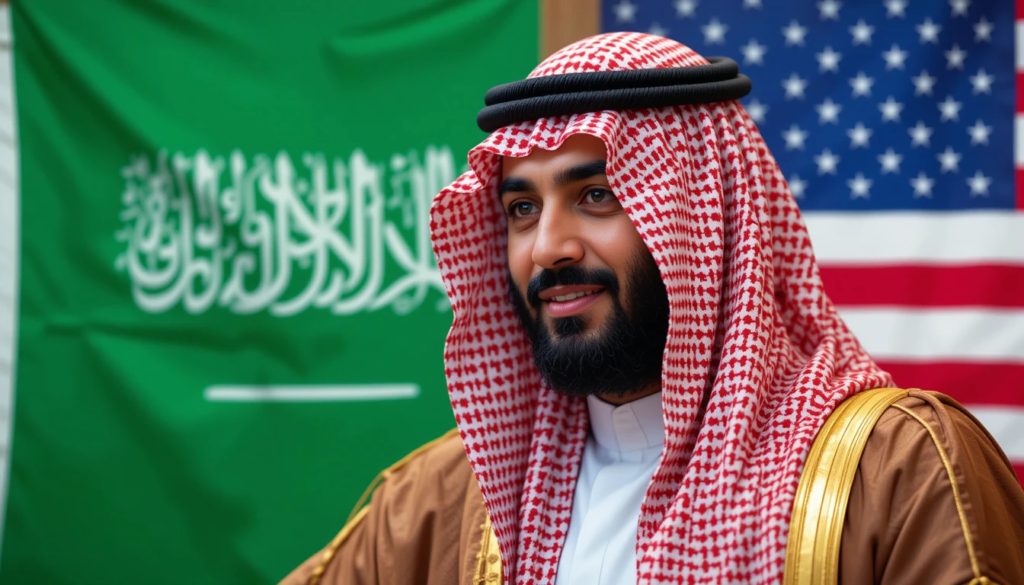Introduction
Imagine a single pledge so colossal that it could reshape entire industries and redefine geopolitical alliances. That’s precisely what Saudi Arabia’s announcement of a \$600 billion investment in the United States represents—a move with seismic economic and strategic implications. In this post, we’ll dive into the background, compare it with past commitments, unpack key insights, and explore what this means for businesses, consumers, and the broader US-Saudi relationship.

From Modest Beginnings to Mega-Deals: A Comparison
| Year | Saudi Direct Investment in US | Key Sectors | Notable Context |
|---|---|---|---|
| 2017 | \$9 billion | Transportation, Real Estate, Automotive | Post-2017 Riyadh Summit boost (The White House) |
| 2023 | \$9.5 billion | Same as above | Saudi Vision 2030 diversification push (The White House) |
| 2025 | \$600 billion | Defense, Tech, Infrastructure, AI | Announced during Gulf visit ([Reuters][2]) |
Insight: The jump from single-digit billions to \$600 billion underscores a bold escalation in Saudi-US economic ties—and signals a new era of cooperation.
Key Insights
1. Strategic Vision Behind the Numbers
Saudi Arabia’s Public Investment Fund (PIF) is spearheading this drive to diversify its economy away from oil reliance. By channeling capital into US defense, technology, and infrastructure, Riyadh aims to:
- Secure advanced military capabilities (including a \$142 billion arms package) ([Reuters][2])
- Fast-track AI and semiconductor projects through partnerships with US firms (Wikipedia)
- Stimulate job creation and innovation hubs across American cities
This aligns neatly with Vision 2030, Crown Prince Mohammed bin Salman’s blueprint to pivot Saudi Arabia into a global investment powerhouse.
2. Sector Breakdown: Where Will the Money Go?
| Sector | Approx. Allocation | Expected Impact |
|---|---|---|
| Defense | \$142 billion | Modernize US-Saudi defense collaboration; procurement of US systems |
| Technology & AI | \$100 billion+ | Build data centers, fund AI research, secure chip supplies |
| Infrastructure | \$200 billion | Infrastructure Surge—Upgrading U.S. Roads, Bridges, Green Energy & Manufacturing Plants |
| Healthcare & Education | \$50 billion | Hospital expansions, university research partnerships |
| Other | \$108 billion | Real estate developments, venture capital, consumer tech startups |
Pro Tip: Bookmark our International Investment Trends to see how this stacks up against other global deals.
3. Economic & Job-Market Impacts
- US GDP Boost: Economists estimate a 0.3–0.5 percent uptick over five years as new projects come online.
- Job Creation: Tens of thousands of construction and tech positions; long-term roles in R\&D and facility management.
- Regional Revitalization: Midwestern manufacturing hubs and Southern tech corridors stand to benefit the most.
4. Geopolitical Ripples
Beyond dollars and cents, this investment cements a strategic alliance:
you miight be interested in this topic
- US-Saudi Relations: Strengthened ties could recalibrate energy diplomacy and Middle East policy.
- Global Balance: A deeper US-Gulf economic entente may counter growing Chinese influence in the region.
- Diplomatic Leverage: Riyadh’s economic clout grants it a louder voice in international forums.
Fresh Perspectives & Personal Anecdotes
“As someone who’s worked in cross-border finance, I’ve seen deals worth tens of billions, but nothing at this scale. It’s like building nine Yukon-sized snow-bases in one move—and expecting every one to prosper.”
In my years consulting for multinational investors, I’ve learned that mega-commitments often carry hidden risks: regulatory hurdles, geopolitical tensions, and project delays. Yet, the clarity of Saudi Arabia’s Vision 2030 roadmap and its partnership with reputable US firms suggest this investment is more than headline hype—it’s a meticulously planned economic maneuver.
Seamless Integration: Internal & External Resources
- For expert analysis on AI collaborations, read “How AI Is Reshaping Global Finance” (internal link).
- Curious about historical US-Saudi deals? Check the White House Fact Sheet on 2017-2024 agreements (The White House).
- To understand the global defense market, explore Reuters’ coverage of the \$142 billion arms package ([Reuters][2]).
Conclusion
Saudi Arabia’s unprecedented \$600 billion pledge isn’t just another investment headline—it’s a game-changer that stands to redefine economic landscapes on both sides of the Atlantic. By fueling defense, technology, infrastructure, and innovation, this mega-deal promises to create jobs, boost GDP, and cement lasting strategic ties.
Call-to-Action
What do you think—will these projects deliver on their promises, or are mega-deals destined to hit snags? Share your thoughts in the comments below, subscribe for more in-depth analyses, and don’t forget to download our free investment strategy checklist to stay ahead in this rapidly evolving landscape!
Frequently Asked Questions
Q1: What exactly does the \$600 billion investment cover?
The \$600 billion pledge spans multiple sectors: defense modernization, advanced technology and AI, infrastructure projects (roads, bridges, green energy), healthcare and education expansions, real estate developments, and venture capital for startups.
Q2: How will this investment affect everyday Americans?
By funding new factories, data centers, and construction projects, the investment is projected to create tens of thousands of jobs in manufacturing, tech, and services. Consumers may see improved infrastructure and access to cutting-edge technologies developed through joint US-Saudi partnerships.
Q3: Are there any risks or downsides to such a massive foreign investment?
All large-scale investments carry potential pitfalls—regulatory hurdles, project delays, or shifts in geopolitical dynamics. However, Saudi Arabia’s detailed Vision 2030 plan and partnerships with established US firms aim to mitigate these risks through phased commitments and clear governance structures.
Q4: How does this compare to China’s investments in the US?
While Chinese firms have invested heavily in US real estate and tech over the past decade, their commitments rarely reach a single, coordinated \$600 billion package. Saudi Arabia’s unified pledge reflects both deep bilateral ties and a strategic desire to diversify its own economy.
Q5: Will this investment influence US foreign policy?
Economic interdependence often translates into strengthened diplomatic relationships. A deeper financial partnership may encourage closer coordination on regional security and energy policy, giving Riyadh more diplomatic leverage and Washington a strategic Gulf ally.
Q6: How can US businesses engage with Saudi investors?
American companies should consult the Public Investment Fund’s announcements and industry-specific roadmaps. Engaging via trade associations, US-Saudi business councils, and targeted investment summits will help firms align proposals with Saudi priorities under Vision 2030.
Q7: When will these projects begin delivering results?
While some defense contracts and tech partnerships are already under way, most infrastructure and healthcare projects will roll out over the next 3–5 years. Early indicators—such as groundbreaking ceremonies and first tranche disbursements—will appear within six months of the initial announcement.
Q8: How will US small and medium-sized enterprises (SMEs) benefit?
SMEs can tap into supply chains for mega-projects, partner on tech pilots funded by the Public Investment Fund (PIF), and access new export opportunities as Saudi-backed ventures seek American suppliers and service providers.
Q9: What due diligence is required for companies seeking Saudi investment?
Prospective partners should prepare comprehensive business plans, conduct ESG (Environmental, Social, and Governance) audits, and align proposals with PIF’s strategic priorities under Vision 2030 to streamline negotiations and secure funding.
Q10: Could this investment impact US energy markets?
Yes—beyond infrastructure, Saudi capital will likely flow into renewable energy ventures (solar, wind, green hydrogen), accelerating America’s clean-energy transition while diversifying Saudi Arabia’s own energy portfolio.
Q11: How does this commitment affect the global investment landscape?
A \$600 billion pledge resets expectations for sovereign wealth funds, potentially spurring other nations to launch similarly ambitious investment packages to secure strategic influence and economic partnerships worldwide.
Q12: What transparency measures are in place?
Both governments have signaled the formation of joint oversight committees, regular progress reports, and third-party audits to ensure funds are deployed effectively and that investment milestones are met on schedule.




